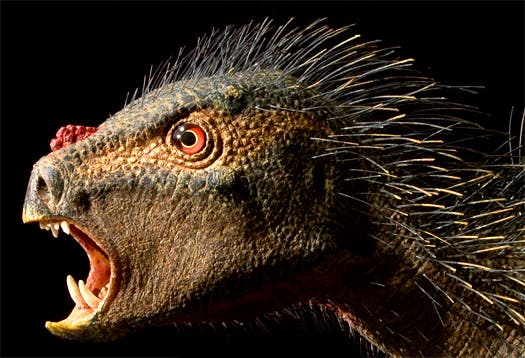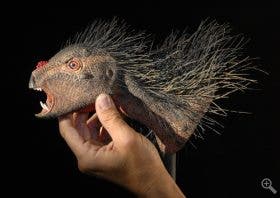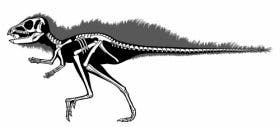
A group of paleontologists recently authored a monograph dedicated to a group of puny herbivore dinosaurs, discovered in the 1960s but only identified as a distinct new species in the past few years. Basically a two-legged porcupine, the Pegomastax africanus puzzled scientists with its distinctly long and sharp fangs, and extremely curious fact for a veggie dinosaur.
Sometimes referred to as the “thick jaw from Africa,” the new species was a mere two feet long and weighed less than a modern housecat. It’s head is what makes it particularly interesting – it had a short parrot-shaped beak up front, a pair of stabbing canines, and tall teeth tucked behind for slicing plants. Just like a pair of scissors, the Pegomastax employed tall teeth in upper and lower jaws, with shearing wear facets that slid past one another when the jaws closed. A bristle line on its head and neck, which gives the dinosaur a punky-look, was most likely employed to make it look bigger.

The sole specimen of the newly appointed dinosaur species was first discovered in the 1960 in South Africa, where it was chipped of a 200-million-year-old red rock. Like many other fossils, it was stashed and forgotten in some storage room, until it was recovered by Paul Sereno, paleontologist and professor at the University of Chicago and National Geographic Explorer-in-Residence, from a fossil collection at Harvard.
“I think the bristles would have made it look at least a little bigger than it was — perhaps they could poke out more strongly when excited,” Sereno said.
“The main defense would be speed of escape,” added Sereno. “These were very long-legged fast critters. (They could inflict) a nipping bite if cornered, using the fangs much like a peccary or fanged deer.”
This weird dinosaur belonged to a class of bizarre fanged plant-eaters called heterodontosaurs, or “different toothed reptiles,” that were among the first dinosaurs to spread across the planet in the early dinosaur era, some 200 million years ago. Around that time the massive, single landmass supercontinent of Pangaea split into two into northern and southern landmasses. Heterodontosaurs also split, as northern species employed simple triangular teeth like the Tianyulong, discovered recently in China and also described in the same study, and the southern species with taller crowns like Pegomastax.

Sereno believes the almost 3-inch-long skull, was most likely adapted to plucking fruit, instead ripping flesh out of animal prey, like its fangs would suggest at a first look. This is supported by the way the teeth met during a bite, their shape, and wear pattern. “Very rare,” admits Sereno, “that a plant-eater like Pegomastax would sport sharp-edged, enlarged canines” like that of a vampire.
“These plant-eaters are among the very oldest we know from the bird-hipped side of the dinosaur tree. They started out small, and some of them got a bit smaller to be among the smallest dinosaurs we know,” Sereno said.
Findings on both the Pegomastax and the Tianyulong have been published in the online journal ZooKeys.
Was this helpful?



